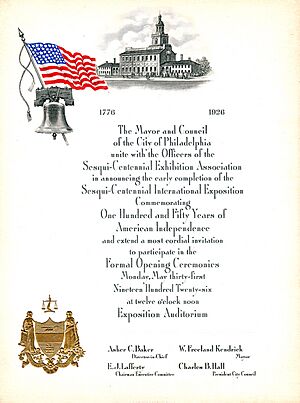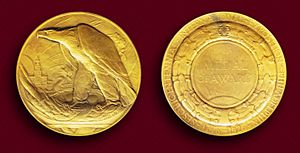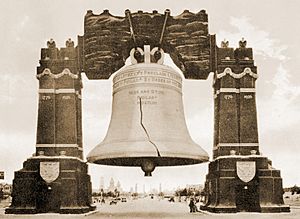Sesquicentennial Exposition facts for kids
The Sesqui-Centennial International Exposition was a big world's fair held in Philadelphia, Pennsylvania, in 1926. Its main goal was to celebrate a very special birthday: 150 years since the United States Declaration of Independence was signed. It also marked 50 years since Philadelphia hosted another big fair, the 1876 Centennial Exposition.
Contents
History of the Fair
Planning the Big Event
The idea for this fair started in 1916 with a man named John Wanamaker. He was the only person still alive who had helped plan the 1876 fair. Philadelphia was growing fast, but it had some problems. Wanamaker believed a new world's fair could help the city feel proud and strong again.
By late 1916, Wanamaker had support from others, like Howard French. They began planning the "Great International Exposition of Philadelphia in 1926." The Fairmount Parkway was chosen as the location. However, in 1917, the United States joined World War I. This meant all plans for the fair had to stop.
After the war, Philadelphia faced tough times. Many people were lost in the war. There was also the Spanish Flu and the challenges of Prohibition. Even with a new mayor, J. Hampton Moore, things felt difficult.
But John Wanamaker never gave up his dream for the fair. In 1919, he spoke about his ideas again. He gained support from other important Philadelphians. The Franklin Institute and the Philadelphia Chamber of Commerce also encouraged Mayor Moore to help. By 1920, Mayor Moore held a meeting to plan the fair. This led to the creation of the Committee of 100.
In 1921, this committee became the Sesqui-Centennial Exhibition Association (SCEA). Mayor Moore was chosen as its president. Wanamaker became an honorary chairman. Philadelphia was officially chosen to host the celebration that same year.
The fair's original plans were very grand. But they had to be made much smaller due to budget cuts. The first director, Colonel David C. Collier, even quit because of this. His replacement, Captain Asher C. Baker, became ill and retired just before the fair opened. E. L. Austin took over at the last minute.
Bringing the Fair to Life
The Sesqui-Centennial Fair opened on May 31, 1926. It stayed open until November of that year. The fairgrounds were in South Philadelphia. This area was once called League Island Park.
Today, this land is home to many familiar places. You can find FDR Park and Marconi Plaza there. It also includes the three big sports stadiums: Wells Fargo Center, Lincoln Financial Field, and Citizens Bank Park. The Philadelphia Eagles training complex is also on part of the old fairgrounds.
A young architect named Louis Kahn helped design the fair buildings. He later became very famous. Sculptor Charles Tefft was in charge of the fair's sculptures. Another well-known artist, Albert Laessle, created the special Medals of Award for the fair.
Fair Highlights and Attractions
One of the most amazing sights was an 80-foot tall replica of the Liberty Bell. It was covered with 26,000 light bulbs! This glowing bell stood at the entrance to the fair.
The Sesqui-Centennial Stadium was built for the fair. It was later known as John F. Kennedy Stadium. Many important events happened here. These included religious ceremonies and a patriotic show called "Freedom." Many sports events also took place. A famous boxing match between Gene Tunney and Jack Dempsey drew 125,000 people. They stood in the rain to watch!
Another highlight was the Curtis Organ. It is still one of the largest pipe organs in the world. In 1926, the first bridge connecting Philadelphia and Camden, New Jersey, was built. This bridge, later named the Benjamin Franklin Bridge, helped people get to the fair.
Important speakers at the opening ceremonies included Secretary of State Frank B. Kellogg. Also there were Secretary of Commerce Herbert Hoover, who later became President. Philadelphia's Mayor W. Freeland Kendrick also spoke.
At the center of the fair was the Forum of Founders. It had beautiful buildings and sculptures. The Tower of Light was also a spectacular sight. Visitors could also walk through a recreated colonial-era High Street. This area had over twenty buildings. Guides dressed in old-fashioned clothes would talk to people.
Treasure Island Amusement Park
The fair also had a fun amusement area called "Treasure Island." It was located inside League Island Park. This area was like a children's paradise, covering more than five acres. There were many rides and shows to enjoy.
Attractions included a miniature railroad and a mountain slide. There was a replica of the Canadian Rockies. Kids could visit Robinson Crusoe's Beach and a pirate's lair. There were also boat rides and Noah's Ark, complete with animals! The fair had several roller coasters too. These included "The Cyclone" and the "Jazz Railway."
Mustin Field Dedication
On September 17, 1926, Mustin Field was dedicated at the Philadelphia Navy Yard. This event honored Captain Henry C. Mustin. He was a Navy Air Pilot who made history in 1915. He was the first to launch a plane from a moving ship.
This dedication was a big event. About 1,500 people watched it. Many important people attended, including Assistant Secretary of the Navy, Theodore Douglas Robinson. Planes from the Army, Navy, and Marine Corps flew in formation to honor Captain Mustin.
Images for kids
See also
 In Spanish: Exposición Internacional del Sesquicentenario para niños
In Spanish: Exposición Internacional del Sesquicentenario para niños





